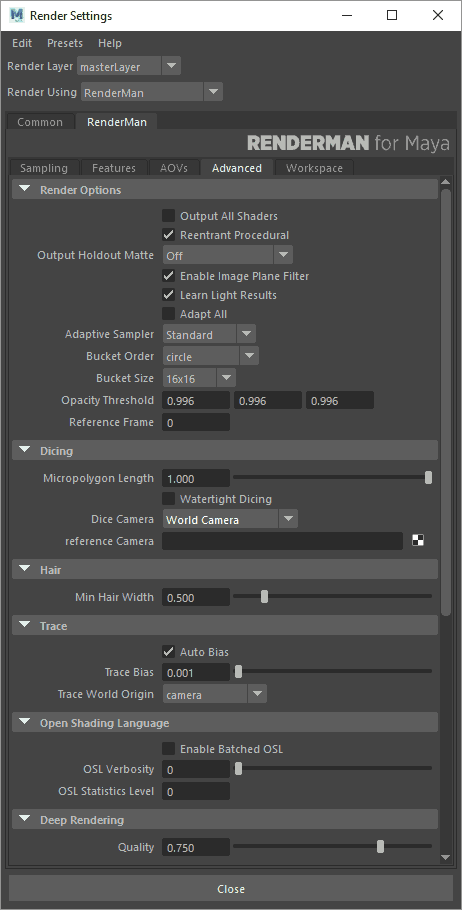Many of the settings in the Advanced Tab you will never need to edit. However, for the more advanced user who wants fine tuned control over RenderMan for Maya, they are here.
Render Options
Enable Object Instancing: Instanced Maya DAGs will be emitted as object instances, providing significant speed and memory benefitsOutput All Shaders: Typically we export only material networks attached to objects, but if you're shading a procedural it may not be connected in a way that is exported. This option will export all networks regardless.
Procedural Reentrant: This allows procedurals to run simultaneously in multiple threads and greatly speed up renders with procedurals (hair). You most likely want to leave this on.
Output Shadow AOVHoldout Matte: When using the Holdout workflow, output the Shadow AOV to this specified buffer.
Enable Image Plane Filter: Render the image plane using the Pixar Image Plane Filter (Maya uses an actual geometric plane)
Learn Light Results: This a new option for scenes with many lights. The renderer will refine the light selection process to improve sampling. This is especially useful in scenes with many occluded lights to avoid wasting samples from shadowed surfaces. This version is not deterministic and small differences can be seen if not well converged on re-renders of the same scene.
Adapt All: Apply the sampling quality criteria (pixel variance) to all color/illumination AOVs. This can increase render time as some AOVs may have more noise than the Beauty and trigger more samples through all the AOVs.
Adaptive Sampler: Make use of the improve sampling algorithms instead of the default. You may need to slightly increase your Pixel Variance setting to avoid longer render times (but better resulting quality on complex images) Your min samples should be set to 0 which has special meaning that the square root of the max samples is used. If you manually input a low value, it will terminate early.
Bucket Order: RenderMan subdivides the output image into small rectangular regions called buckets, and renders a single bucket at a time. This allows a small portion of the image to be in memory at any one time. The drop-down list allows users to choose the order in which buckets are displayed in "it" or the Render View. The default is Spiral. Note that only some bucket orders are supported for checkpointing and recovery.
...
Opacity Threshold: Controls the Opacity Threshold, if set too low, it may terminate rays early on semi-opaque objects. An objects opacity is controlled by the material Presence parameter and depth in supported integrators.
Reference Frame: Once per job passes and static objects are evaluated at the frame designated here.
...
Dicing Camera: Enables the use of a reference camera for dicing. This can be done globally, or restricted to specific objects (e.g. objects with displacements that "sparkle" as the camera moves) by also attaching this as a per-object attribute.
Reference Camera: Specify the camera to be used as your dicing camera here. Click on the widget to create a new camera, or right click in the field to select an existing camera. Note that the Reference Camera needs to be different from the render camera.
...
- "world" (default) uses the true world origin
- "worldoffset" use user provided trace:worldoffset as the raytrace world origin ( the control will expose an XYZ coordinate field)
- "camera" use the camera position as the raytrace world origin, you may wish to use this in large scenes with multiple camera positions as the default.
Open Shading Language
Enable Batched OSL: Enable performance improvements on batched shading points through vectorized instructions on supported hardware. (Available on machines with a minimum of support for Advanced Vector Extensions (AVX). Additionally, it can take advantage of the 512-bit wide datapaths on machines that support Advance Vector Extensions 512 (AVX-512). This is on by default
OSL Verbosity: Valid in ranges of 0 to 5 with 5 having the most messages. See the OSL documentation for more information.
OSL Statistics Level: As above, valid in ranges of 0 to 5 with 5 having the most messages.
Deep Rendering
Quality: Controls the decimation rate of merging samples. A setting of 1.0 has no merging of samples and will generate huge files. The default of 0.75 maps to Deepshadow Error 0.01 and when set to 0 maps to Deepshadow Error 0.16. Note this is not a linear mapping.
Crop Window
Enable: Use the crop window, off (default) renders the complete frame based on camera settings
...
Level: Enable this to output diagnostic information from render jobs. Useful for timing, debugging, and seeing what RenderMan is doing. Higher numbers are more verbosity. Note there can be a performance impact that adds up by requiring the renderer to lookup these strings.
...

